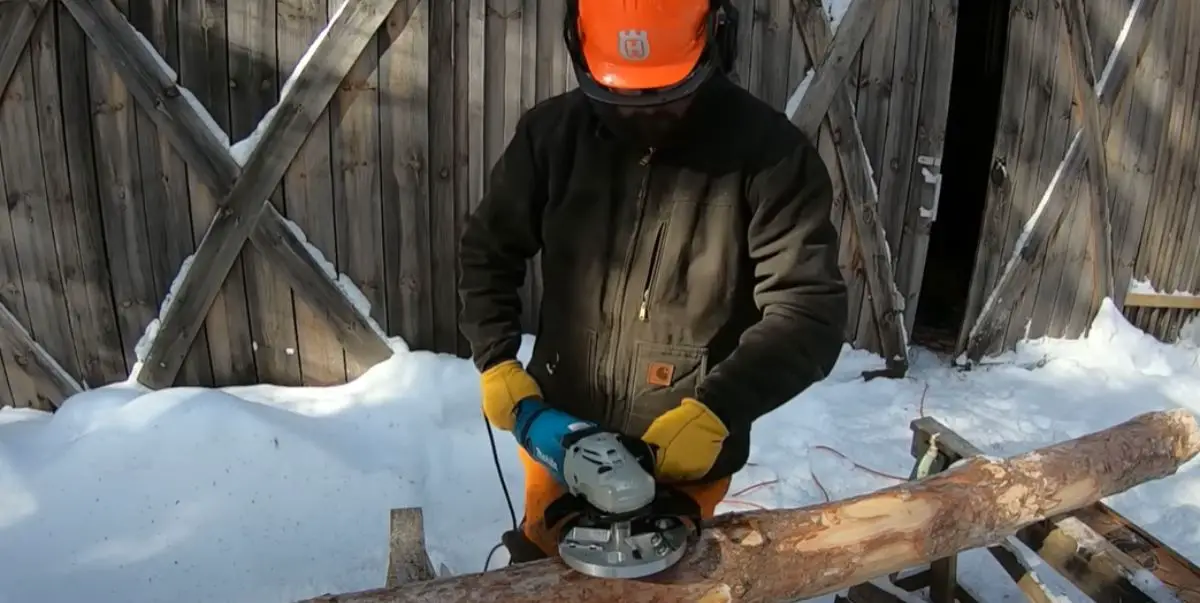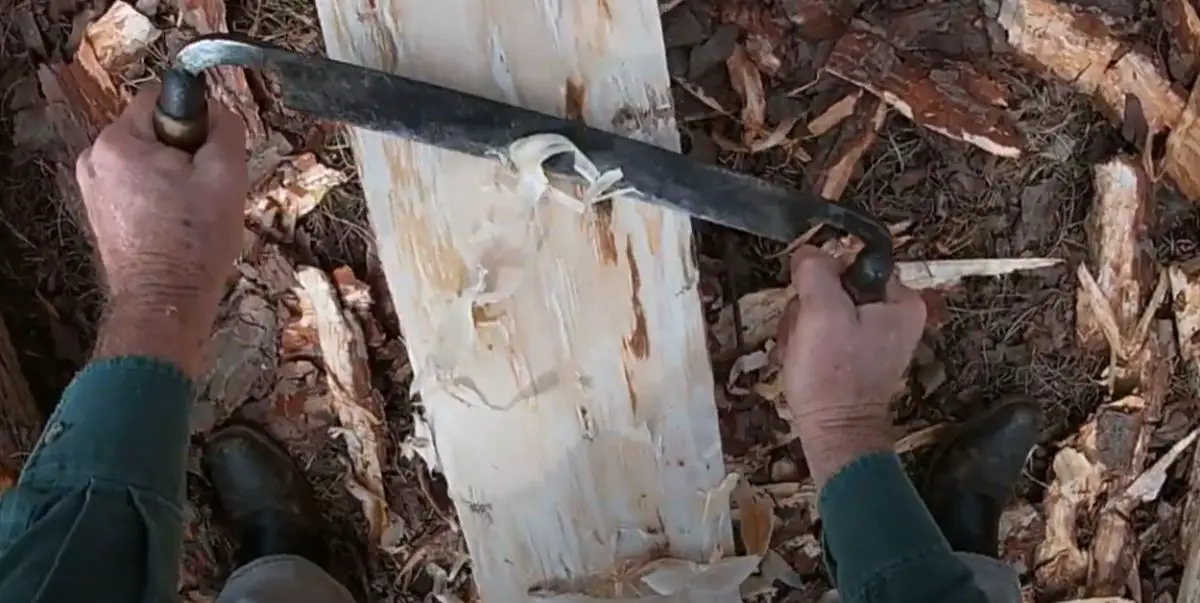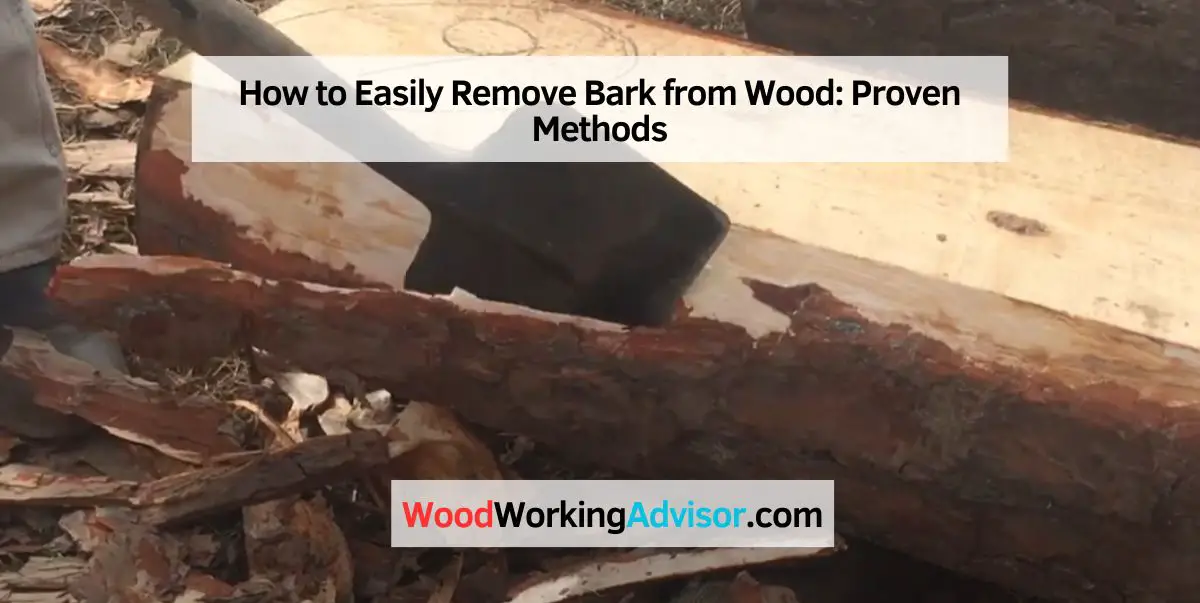To remove bark from wood, gently use a chisel or pry bar to peel it away. Bark can be an eyesore and potential hazard on wood surfaces, whether it’s a tree trunk or a piece of firewood.
Fortunately, removing bark is a relatively simple process that can be done with just a few tools. By using a chisel or pry bar, you can carefully peel away the bark from the wood, revealing a clean and smooth surface.
This not only enhances the appearance of the wood but also makes it safer to handle. We will discuss the step-by-step process of removing bark from wood, as well as some tips for ensuring a successful bark removal. So, let’s dive in and explore the methods for removing bark from wood!
Understanding The Importance Of Removing Bark
Removing bark from wood is essential to prevent rot and infestations, and to enhance the wood’s aesthetic appeal. The process involves using a debarking tool or a drawknife to carefully strip away the bark, resulting in smoother and more polished wood surfaces.
This is especially important for woodworking and crafting projects.
When it comes to working with wood, removing the bark might seem like a tedious task. However, understanding the importance of removing bark is crucial for both preventing pests and insects and improving the woodworking process.
Preventing Pests And Insects
Removing bark from wood is essential for keeping pests and insects at bay. Bark provides a protective layer for insects like termites, ants, and beetles, serving as their shelter and food source. By removing the bark, you eliminate their hiding place and reduce the risk of infestation. Additionally, some pests and insects can cause severe damage to wooden structures, compromising their integrity. By preemptively removing the bark, you can safeguard your wood from such destructive creatures.
Improving Woodworking Process
Removing bark also has its advantages for woodworking enthusiasts. The bark contains moisture, and when wood is processed with the bark still attached, it can lead to warping and cracking. By removing the bark, you ensure that the wood is properly seasoned and ready for use in various woodworking projects. This is particularly important for intricate and delicate designs, as bark-free wood provides a smoother and more stable surface to work with. Removing the bark also helps to reveal the natural beauty of the wood, allowing the grain and texture to shine through without obstructions.
In addition, removing the bark can facilitate the staining and finishing process. Bark can be challenging to stain evenly, causing discoloration and an inconsistent finish. By removing it, you ensure a more uniform and professional-looking end result. Moreover, it reduces the likelihood of the finish peeling or chipping off due to the irregular surface caused by the bark.
Some key benefits of removing bark from wood are:
- Prevents infestation by pests and insects like termites, ants, and beetles.
- Protects the integrity of wooden structures by eliminating potential sources of damage.
- Prevents warping and cracking, keeping the wood stable and ready for use in woodworking projects.
- Reveals the natural beauty of the wood, showcasing its grain and texture.
- Facilitates the staining and finishing process for a more uniform and professional appearance.

Tools And Equipment For Bark Removal
Learn how to easily remove bark from wood with our selection of high-quality tools and equipment specifically designed for this task. Our range includes effective solutions for safely removing bark from different types of wood, ensuring a professional and precise result every time.
Removing bark from wood can be a tedious task, but with the right tools and equipment, it can become a much easier and more efficient process. Whether you are a professional woodworker or a DIY enthusiast, having the proper tools at your disposal can make all the difference. In this section, we will discuss the essential tools you need to have for the job as well as optional equipment that can further enhance your efficiency.
Essential Tools For The Job
When it comes to removing bark from wood, there are a few basic tools that you absolutely need. These tools are essential for effectively and safely removing the bark without causing damage to the wood. Here are the essential tools you should have:
- Bark Spud
- Wooden Mallet
- Chisel Set
- Wire Brush
- Safety Gloves
- Eye Protection
These tools work together to provide you with the necessary means to remove bark effectively. The bark spud is specially designed to pry and lift the bark away from the wood, while the wooden mallet and chisel set help in carefully chipping away the bark. The wire brush is useful for cleaning any residual bark pieces from the wood’s surface.
Optional Equipment For Efficiency
While the essential tools mentioned above are enough to get the job done, there are optional equipment that can significantly improve your efficiency and make the process even easier. Here are some optional equipment you might consider:
- Power Washer
- Air Compressor
- Rotary Tool
- Sanding Block
A power washer can help remove stubborn bark or dirt from the wood, while an air compressor can assist in blowing away loose bark. A rotary tool with a sanding bit can be used for precise and detailed work, especially in hard-to-reach areas. Having a sanding block on hand can help smoothen the wood’s surface after bark removal.
Remember, having this optional equipment is not necessary but can make the bark removal process faster and more efficient. Assess your needs and budget before deciding on investing in these additional tools.
No matter if you choose to use just the essential tools or include optional equipment, having the right tools and equipment for removing bark from wood is crucial. It not only ensures that the job is done effectively and safely but also saves you time and effort in the long run.
Method 1: Hand Tools For Bark Removal
Bark removal is a crucial step in woodworking. Using hand tools is one of the most common methods for removing bark from wood. Not only does it give you a sense of control, but it also allows you to preserve the natural shape of the wood. Below, we look at two hand-tool methods for bark removal.
Using A Drawknife
A drawknife is a versatile tool that can be used for a variety of woodworking tasks, including bark removal. The thin, sharp blade allows for precise shaving of the bark. Begin by firmly gripping the wood and using the drawknife to shave off the bark in long, controlled strokes. Ensure that the drawknife is sharp to avoid tearing the wood fibers. Work your way around the wood, taking care to remove all the bark. This method is best suited for large pieces of wood with thicker bark.
Utilizing A Chisel And Mallet
Another effective method for bark removal is using a chisel and mallet. This method is ideal for smaller pieces of wood or areas with intricate shapes. Start by making small cuts along the edges of the bark to loosen it from the wood. Then, gently tap the chisel with a mallet to peel the bark away. Take your time and work methodically to avoid damaging the wood. Once the bark is removed, use a sanding block to smooth out any rough areas. This method allows for detailed bark removal while preserving the natural contours of the wood.
Method 2: Power Tools For Bark Removal
When it comes to removing bark from wood, using power tools can make the task faster and more efficient. Power tools have the strength and precision needed to get rid of stubborn bark without damaging the wood underneath. In this method, we will explore two popular power tools for bark removal: a power washer and a rotary tool with a wire brush.
Using A Power Washer
A power washer is a versatile tool that can be used for various cleaning tasks, including bark removal from wood. Here’s how you can use a power washer to remove bark:
- Fill the power washer’s reservoir with water or a cleaning solution suitable for wood.
- Adjust the nozzle settings to a medium-pressure spray. This will ensure the bark is removed effectively without causing any damage to the wood surface.
- Begin spraying the wood surface with the power washer, focusing on areas where bark is present. Hold the power washer nozzle at a slight angle to avoid any direct pressure on the wood.
- Move the nozzle in a back-and-forth motion, gradually working your way across the entire wood surface. Continue spraying until all the bark is loosened and removed.
- After bark removal, allow the wood to dry completely before applying any finish or stain.
Utilizing A Rotary Tool With A Wire Brush
A rotary tool with a wire brush attachment is another effective power tool for bark removal. Here’s how you can use it:
- Ensure you have the right rotary tool and wire brush attachment for your needs. Consider using a brush with stiff bristles for more efficient bark removal.
- Put on protective eyewear and gloves before you begin.
- Hold the tool with a firm grip and position the wire brush against the wood surface where the bark is present.
- Switch on the rotary tool at a moderate speed. Gently guide the wire brush along the bark, applying even pressure to remove it.
- Continue moving the wire brush across the wood until all the bark is removed. Take care not to stay in one area for too long, as this can damage the wood.
- Once the bark is gone, use a clean cloth or brush to remove any remaining bark remnants or dust.
By following these methods using power tools, you can easily and efficiently remove bark from wood, leaving behind a smooth and clean surface.
Finishing Touches And Tips
Discover effective methods for removing bark from wood with these finishing touches and tips. Say goodbye to unsightly bark remnants and achieve a smooth, polished surface effortlessly.
Sanding The Wood Surface
To achieve a smooth and polished finish on your wood surface, sanding is a crucial step. Start by using a coarse grit sandpaper, such as 80 or 100, to remove any remaining bits of bark or rough patches. Sand the wood with the grain in long, even strokes, applying light pressure.
Once the rough areas are smoothed out, switch to a finer grit sandpaper, like 120 or 150. This will help you achieve a finer finish and prepare the wood for the protective coating. Again, sand with the grain, making sure to remove any visible roughness. Take your time during this step to ensure a flawless surface.
Applying A Protective Finish
After sanding, it’s important to apply a protective finish to the wood surface. This not only enhances the appearance but also provides durability and safeguards against future damage. There are various types of finishes you can choose from, such as varnish, polyurethane, or shellac.
Pro tip: Before applying any finish, it’s crucial to clean the wood surface thoroughly to remove any dust or debris. This ensures proper adhesion and a smooth finish.
Using a brush or a clean cloth, apply the finish evenly in the direction of the grain. Start by applying a thin coat and allow it to dry completely. For optimal protection, it’s recommended to apply multiple coats following the manufacturer’s instructions regarding drying time between coats. Remember to lightly sand the surface in between coats to remove any imperfections and promote adhesion.
Pro tip: If you prefer a more natural look, consider using an oil or wax finish. These finishes not only enhance the wood’s natural beauty but also provide protection.
Once the final coat is applied and dried, your wood surface will have a beautiful and protective finish, ready to be displayed or utilized for various purposes.

Frequently Asked Questions Of How To Remove Bark From Wood
What Is The Easiest Way To Remove Bark From Wood?
The easiest way to remove bark from wood is by using a sharp tool, such as a chisel or drawknife, to carefully pry it off. It’s essential to work in the direction of the wood grain for optimal results. Thoroughly sand the area after removing the bark for a smooth finish.
What Is The Best Tool To Remove Bark?
The best tool for removing bark is a bark peeler tool. It is designed specifically for this task, making it efficient and effective. It easily strips the bark of trees and logs, saving time and effort. Using a bark peeler tool is the ideal choice for bark removal.
How Do You Debark A Tree?
To debark a tree, use a sharp tool to carefully remove the bark. Work in sections, making shallow cuts to avoid damaging the tree. Be cautious not to cut too deep into the tree’s cambium layer. Take proper safety precautions and carry out the process during the appropriate season.
How Do You Remove Live Edge Bark?
To remove live edge bark, use a chisel or hammer to carefully pry it off. Ensure to work slowly and steadily to avoid damaging the wood. Sand the edges afterward for a smooth finish. Additionally, applying a sealant can help protect the exposed wood.
Conclusion
Removing bark from wood can be a challenging but rewarding task. By following the right techniques and using the appropriate tools, you can reveal the natural beauty of the wood underneath. Whether you’re working on a DIY project or professional woodworking, knowing how to effectively remove bark from wood is a valuable skill to have.
Mastering this process can lead to stunning finished products that showcase the inherent splendor of the wood.


